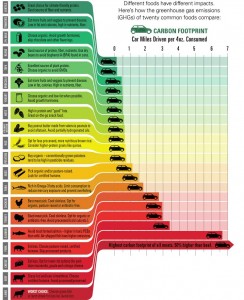The Environmental Working Group (EWG) recently released their findings on the climate impacts of eating twenty different proteins, ranging from lentils to lambs. The data took into account all of the resources put into producing these common foods, a method known as life cycle assessment. One resource that sometimes goes without notice is the production of animal feed, which uses vast amounts of land, water, pesticides, and chemical fertilizer, each of which have their own environmental impact. The study even takes into account the disposal of unused foods post-production.

Lamb, beef, and pork were the three meats with the highest carbon footprint, but cheese ranked third worst overall. Two percent milk, by contrast, ranked third best. This discrepancy is caused by the intensive production of cheese. “It takes about ten pounds of milk to make one pound of cheese,” said Kari Hamerschlag, author of the report. To give the data more real-world impact, a colorful chart shows the footprint of each food in terms of car miles driven per four ounces consumed. Lamb, the highest, is more than seven miles for each portion eaten.
Lentils, tomatoes, milk, and beans were the four best proteins, each contributing a fraction of one mile per four ounce serving. Chicken, the most environmentally-friendly land animal on the list, comes in at about 1.75 miles. Tuna is much better than chicken, but salmon, especially farmed salmon, is slightly worse. Smaller, plant-eating fish like tilapia, not listed, have a smaller impact because they are lower on the food chain.
Rather than promoting strict vegetarianism or veganism, the EWG instead points out the American over-consumption of meat and suggests a reduction in portion sizes. In 2009, the United States produced 208 pounds of meat per person for domestic consumption alone, almost 60 percent more than Europe. Additionally, the study states that eliminating meat and cheese from one meal a week for a year would be the equivalent of taking 7.6 million cars off the road.
By Kamaria Greenfield

Danielle Nierenberg, an expert on livestock and sustainability, currently serves as Project Director of State of World 2011 for the Worldwatch Institute, a Washington, DC-based environmental think tank. Her knowledge of factory farming and its global spread and sustainable agriculture has been cited widely in the New York Times Magazine, the International Herald Tribune, the Washington Post, and
other publications.
Danielle worked for two years as a Peace Corps volunteer in the Dominican Republic. She is currently traveling across Africa looking at innovations that are working to alleviate hunger and poverty and blogging everyday at Worldwatch Institute’s Nourishing the Planet. She has a regular column with the Mail & Guardian, the Kansas City Star, and the Huffington Post and her writing was been featured in newspapers across Africa including the Cape Town Argus, the Zambia Daily Mail, Coast Week (Kenya), and other African publications. She holds an M.S. in agriculture, food, and environment from Tufts University and a B.A. in environmental policy from Monmouth College.








